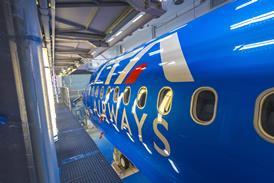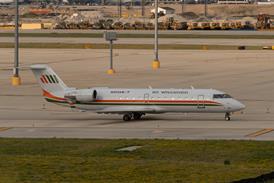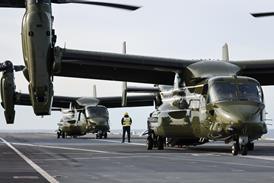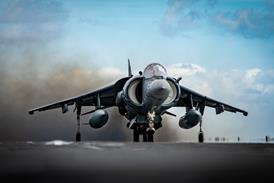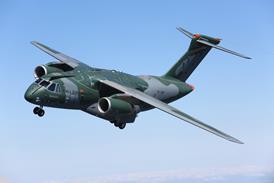The Bombardier Learjet 85 at first glance may look like just another member of the Learjet family, but almost everything about this business jet is new.
When it enters service in 2013, the Learjet 85 will be the first all-composite business jet and the first all-composite aircraft to be certificated under US Federal Aviation Administration Part 25 airworthiness standards. All the major structures will be manufactured in a country new to Bombardier - Mexico. It also will be the first clean-sheet design Bombardier has introduced in more than a decade.
From a performance perspective, the Learjet 85 will fly faster and longer than any previous member of the family. It will be significantly larger, with a 40% longer wingspan.
 |
|---|
© Bombardier |
Inside, the 7.54m (24.7ft)-long cabin will be roomier than any Learjet ever built and feature new amenities such as a vacuum toilet with external water fill. The Learjet 85 will be able to accommodate up to eight passengers plus two pilots with 12m2 (130ft2) of baggage space, including 2.8m2 in the interior. The cabin, which will be 1.8m high, will be taller than any earlier Learjet model.
The cockpit will also have several Learjet firsts including a head-up display, along with enhanced and synthetic vision. A tiller has been added for low-speed steering.
For the Learjet 85, Bombardier is also taking a new approach to development. The programme is in the joint development phase (JDP), but teams are already in place across three sites in three countries. Bombardier Business Aircraft in Montreal is responsible for structural detail design with more than 200 employees now working on the programme.
At Bombardier's Learjet unit in Wichita, there are almost 200 employees working on the Learjet 85, with responsibility for systems integration and certification. Wichita also has started preparing for final assembly of the aircraft with new lean manufacturing techniques being introduced before the start of production.
Finally, at Bombardier's Mexico Manufacturing Centre in Queretaro, there are over 50 employees assigned to the Learjet 85. Once the aircraft is in production, Mexico will be responsible for most of the work, manufacturing all the major components including the wing and fuselage. Mexico will also manufacture electrical harnesses and be responsible for subassembly systems installation.
There are more than 40 suppliers on board, including Pratt & Whitney Canada for the engine and Rockwell Collins for the avionics. As part of the JDP, suppliers are on site working with Bombardier engineers on design concepts. Earlier this year Wichita's National Institute for Aviation Research was also enlisted to help with the certification effort, including static article and coupon testing.
The basic configuration has been defined and a digital mock-up completed. Bombardier also completed in Montreal this year windtunnel testing and two proof-of-concept fuselages, with a third proof-of-concept fuselage to be completed in 2010 in Mexico. The detail design process will begin early that year.
Learjet 85 vice-president Ralph Acs says the engineering team is now working on harmonising and finalising the architecture in preparation for detailed design. "It's in this phase you are making all the key decisions for 2013 when we go into service," he says.
Acs adds that "a multitude" of "super decisions" have been made this year, including the choice of vacuum toilets and tiller steering. Key decisions were moved to earlier in the programme compared with previous Bombardier development projects. The airframer also established at an unusually early stage three focus groups to help it make selections in three key areas - maintenance, the cockpit and interiors.
 |
|---|
Face-to-face meetings have been held annually with each of three focus groups, which are composed of Learjet customers, with regular updates via video conferencing. "In a lot of our decisions the focus groups have weighted heavily. For example vacuum toilets are very much more expensive for us, but in the end it's the right decision," Acs says.
Earlier Learjet models only have a gravity toilet without an external water fill. Acs says the interior will also feature improved ergonomics and storage as well as more "creature comforts" compared with earlier models.
AVIONICS CHANGED
In the cockpit all the avionics have been changed and the Learjet 85 will be the first Learjet with paperless capability. In the decade that has passed without a completely new Learjet model there have been several breakthroughs in the world of cockpit technologies. As a result, Learjet has some catching up to do but is also keen to use the Learjet 85 to leapfrog over the competition.
For example, HUDs and enhanced vision systems (EVS) have started to become common in large business jets. Learjet 85 programme director Larry Thimmesch says these products "straddle the Learjet line", but the manufacturer wants to "raise the bar" and offer them on the midsize Learjet 85.
"You have a lot of those Challenger things the customer wants that you won't typically find in a Learjet because we are redefining the segment," Thimmesch says.
A single HUD and EVS will be offered as options to supplement the Pro Line Fusion avionics suite. A synthetic vision system will be standard.
Bombardier has also worked with the pilots that sit on the cockpit user group to arrive at a cockpit design as clean and elegant as possible. Thimmesch says the result is a cockpit "that doesn't look like a commercial aircraft cockpit" and looks more like an extension of the Learjet 85 interior. "It's a very clean, well organised ergonomic cockpit," he says.
 |
|---|
© Bombardier |
He adds that the cleaner cockpit design, which focuses on keeping the amount of switches to a minimum, should result in reduced pilot workload and improved situational awareness. A mock-up of the cockpit, which was unveiled in 2008 at the NBAA business aviation convention in Orlando, has been revised in time for this year's show. Thimmesch says members of the cockpit user group will have an opportunity to sit during NBAA in the revised cockpit, which he says is 99% representative of the actual aircraft, to make sure Bombardier "got it right and we interpreted their inputs right".
The decision to add a tiller for low-speed steering was also made as a result of input from the cockpit user group. Earlier Learjet models and the initial Learjet 85 design only had rudder steering, which will still be used on the Learjet 85 at higher speeds.
"We've never had a tiller in a Learjet, but the focus group came back and said, 'in this class of aircraft we want a hand tiller. We don't want to steer with foot pedals'," explains Thimmesch. "We transformed what a Learjet is. It's starting to feel more like a bigger aircraft so you get those capabilities."
The Learjet 85 will also perform like a bigger aircraft. Thimmesch says the ceiling has been reduced to 49,000ft compared with 51,000ft on earlier Learjet models to maximise the aircraft's performance, explaining that "49,000ft gave [customers] a much better product and no-one cruises at 51,000ft anyway". But all other performance specifications from earlier Learjet models have been maintained or improved.
Range will be 5,555km (3,000nm), compared with 4,070km on earlier models. "That's a new level of capability. Range in itself brings in a whole new aspect," Acs says.
The Learjet 85 will able to cruise at Mach 0.82, or 1% faster than the M0.81 top speed of earlier models. Take-off performance has also been slightly improved. The Learjet 85 should be able to take off at the maximum take-off weight of 15,195kg (33,500lb) in 1,465m, compared with 1,585m in the lighter Learjet 60. Thimmesch says beating the 1,525m (5,000ft) mark was key because in the US there are hundreds of general aviation airports with runways of that length.
CLIMB PERFORMANCE
Thimmesch says Learjet has made sure other performance specifications are maintained from earlier models, including climb performance. "One of the things we've said is we can't lose what a Learjet has," he says. "Learjet is known for performance. One key parameter is climb performance. We must climb as fast as the Learjet 60, which is best in its class. One of our parameters is 18min to climb to flight level 41. This aircraft has to meet this requirement."
He says this is particularly important because the Learjet 85 is being marketed as an update for owners of existing Learjets. "You are moving Learjet customers up, but they don't want to lose something they had before," he says. "If you were in a Learjet 60 you want more baggage volume, but you still want that legendary performance. Keep the things that are good, but improve the things that can be improved. The Learjet 85 has got the largest cabin in its class [but] it's also got to have the performance of a Learjet."
So far Bombardier has secured more than 60 orders for the Learjet 85. Learjet vice-president and general manager David Coleal says many of the customers already have Learjets or other Bombardier aircraft. He points out at $17 million the aircraft is targeted at "a greatly underserved market" between the more expensive Challenger 300 and cheaper Learjet 60. "There is pretty big jump from the Learjet 60 to Challenger 300 price point. Customers wanted a nice transition," Coleal says.
 |
|---|
© Bombardier |
The unprecedented use of composites in all the major structures is a key driver in Bombardier's ability to provide a lot of capability while meeting the $17 million price point. "The holy grail with composites is typically you can build them faster with less cost," Coleal says.
Bombardier has opted to use pre-preg composites, which Coleal says ensures the manufacturer will not have the same problems Boeing has experienced on the 787. Grob was originally meant to build the first three Learjet 85 prototypes using wet-lay composites. After the German company's insolvency in 2008, Coleal says Bombardier had to make a quick decision to keep the programme on schedule. Bombardier decided to in-source the design work and production of the prototypes using the pre-preg technique. Coleal says that within 30 days more than 1,000 engineers in Montreal were brought into the programme to "toil away on a new design".
| BOMBARDIER'S 'RECIPE' FOR NEW BUSINESS JETS WHILE Bombardier's Learjet unit has not produced an all-new design in more than a decade, Bombardier has compensated for any lack of recent engineering experience in Wichita by assigning some of its most experienced Montreal-based staff to the Learjet 85 project. Montreal-based Learjet 85 vice-president Ralph Acs previously oversaw the Global Express and Challenger 300 programmes and says his team has been involved in the development of several successful business jet programmes. "We have a team of knowledgeable individuals and what we do is these kinds of big programmes for Bombardier," he says. Acs adds the Learjet 85 essentially follows the "recipe" that Bombardier used in developing the Challenger 300. "We take that recipe and we really try to work it. The Learjet 85 is just the next aircraft, which happens to be a Learjet, to really benefit from the recipe. The recipe is a way of thinking, it's a culture and it's a set of processes. So it's a mindset that comes with it. You have the people, the continuity of product development type people who know the history, know what works and what doesn't work." Acs acknowledges the Learjet 85 is much different than the Challenger 300 or Global Express as it a much smaller and less expensive aircraft. But he says while applying the "recipe" of large business jets to a midsize jet may be challenging, it is achievable. "Smaller just means it's a bit more challenging for the packaging," Acs says. "The basic design philosophy is the same. You have a lower price point so now you take the design team to a new level for cost consciousness." |
Learjet 85 operations general manager Alan Young adds: "The model with Grob is totally different. We took the Grob design and Bombardierised it."
In hindsight Bombardier made a smart move earlier in 2008 in deciding to bring in for the Learjet 85 programme several composite experts including Coleal, who previously worked with composites at Cirrus Aircraft. Young, who previously worked with composites at Vought Aircraft, says in designing the composite wing Bombardier also has been able to leverage its experience in Belfast, which unlike Montreal has years of experience in working on composite structures.
Belfast is developing the composite wing for the new CSeries small airliner. "It's good when you have two aircraft programmes going together. We're learning and we're leveraging very closely with the CSeries," Young says.
CSERIES WING
A team of Learjet executives visited Belfast in July to look at the CSeries proof-of-concept wing, which Belfast has already produced. Coleal says the team realised Learjet could save on resources and "take out a lot of risk" by "leveraging their geometry". Essentially, Learjet has taken the CSeries wing design and "overlaid it on the 85". As a result Learjet will not have to build a test article for the Learjet 85 wing, saving significant research and development dollars.
Thimmesch says the wing, which at 18.7m is significantly longer than any previous Learjet wing, is a key driver in the improved performance over existing models. He says the wing's "good low-speed visibility" was particularly crucial in beating the 1,525m take-off performance target. Each side will have two Fowler flaps, two spoilers and no slats. The aerofoil design includes removable winglets that are more curved compared with the winglets on existing Learjet models.
Thimmesch says the selection of the P&WC PWC307B turbofan engine, which provides 6,100lb of thrust (27kN) at take-off compared with the 4,600lb provided by the PWC305A powering the Learjet 60, was also a key factor in driving several of the performance improvements. In addition to providing more thrust, Thimmesch says the PW307B has lower emissions and fuel burn than older powerplants, making it more environmentally friendly.
 |
|---|
To see the full size cutaway, click on the image above |
The Learjet 85 will not only have a unique feel for the pilot and passenger. The aircraft has also been designed to be different than earlier Learjet models from the mechanics' perspective. The result should be a more reliable aircraft from first delivery.
"One thing we are doing fundamentally different is what we are doing for entry into service readiness," Thimmesch says. "No matter who builds an aircraft it typically takes two years to get the maturity where you want it. We want it to be mature right out of the box."
Acs adds: "Even though entry of service for us isn't until 2013, we've spent an incredible amount of time getting ready for it."
Thimmesch says a key component of this new approach to readiness involves designing the aircraft to facilitate easier maintenance and troubleshooting. Part counts and the number of components used have been drastically reduced. Smart probes will be used to help mechanics pinpoint items that need to be replaced, potentially saving hours compared with the traditional troubleshooting process.
"To be reliable at service entry we have to think, 'how can we do this be different?' We really have to fundamentally do something different," Thimmesch says. "Product design is a piece of it. The whole maintenance programme, customising maintenance, validating all the tasks through flight test, making sure everything is proven out. We are even doing validations on the rigs, which we've never done on a Learjet platform before. As soon as you have something to touch and feel go validate your maintenance tests."
He adds: "We have the maintenance team involved very early on in the programme so we can start validating the systems while we can still influence design because we want the customer to really appreciate high reliability right out of the box. So fundamentally these things are different. There's a whole integration team that is just driving this across the programme."
Acs adds that the rig has played a crucial role in making sure the design and all the components are reliable. This ensures there are no surprises during the flight-test phase and ensures the flight tests will be "more about validating, not developing". He says Bombardier also has been careful in choosing a design that is not simply "good for manufacturing", but "a design that is well-rounded and is the right design for the customer, taking into account lifecycle costs and reliability".
Thimmesch says the idea of focusing heavily on customer support during the design phase was introduced at Bombardier for the Challenger 300 programme. But he says Bombardier decided to involve this component even earlier for the Learjet 85.
He says this involves looking at how much the aircraft will cost to fly during the entire lifecycle. He says historically a manufacturer gets a requirement for a customer and then focuses on building the aircraft. This time the customer has been involved constantly, receiving regular updates and providing input as work on the design continues. "It's not a one-step process. We are doing it to a very extensive level," Thimmesch says. "The customer has had so much influence from the beginning."
Source: Flight International


